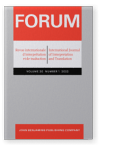Vol. 20:1 (2022) ► pp.134–157
A diachronic corpus-driven study of fansubbing
Do the presentation standards employed by the fansubbers in Iran change over time?
What is of interest here is whether subtitling community in a country changes over time. Particularly, by taking a diachronic approach to AVT, the present paper attempts to investigate the degree of conformity of Iranian fansubbers to professional subtitle presentation standards to see if any change has happened in the behavior and characteristics of Iranian fansubbing community over time. To this end, we developed a diachronic corpus of subtitles consisting of 50 films belonging to 2008 and 2018, a decade later, to gauge variations (violations) from a set of standards. The findings suggest that generally fansubbers, although possibly unconsciously, show a higher degree of conformity to professional subtitle presentation standards over time. Concludingly, the fan AVT in Iran, in the corpus under investigation, has evolved in terms of professionalism. Finally, the changes seen in the community can call for some possible modifications required to update or revise the present standards.
Article outline
- 1.Introduction
- 2.Literature review
- 2.1Corpus-based AVT background
- 2.2Fansubbing in Iran
- 3.Methodology
- 3.1Problems and limitations in data collection
- 3.2Corpus design
- 3.3Framework and analytical tools
- 4.Analysis of the corpus and results
- 4.1Expected reading speed
- 4.2Maximum single- and double-line subtitle length
- 4.3Maximum single- and double-line subtitle duration
- 4.4Maximum number of lines
- 4.5Minimum duration of a single-word subtitle
- 5.Concluding remarks
- 6.Limitations and suggestions for further research
-
References
